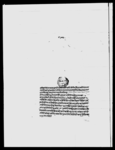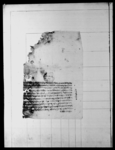A lālamohara from King Surendra confirming the sale of a sunābirtā belonging to Bhāju Dhan and Pāḍau Siṃ Lākhe (VS 1932)
ID: DNA_0013_0108
Edited and
translated by Simon Cubelic and Rajan Khatiwoda
in collaboration with
Ramhari Timalsina
Created: 2014-10-06;
Last modified: 2017-11-08
For the metadata of the document, click here
The accompanying edition, translation/synopsis and/or commentary are available under the terms of the Creative Commons Attribution-ShareAlike 4.0 International License
Abstract
This lālamohara from King Surendra, issued in VS 1932 (1875/76 CE), confirms the sale of a sunābirtā by Bhāju Dhan and Pāḍau Siṃ Lākhe from the Ṭunanī section of Tachu Ṭola in the city of Ṭhimī to Jasarāma Sālmī from the Sānanī section of Ināya Ṭola in the city of Bhaktapur.Diplomatic edition
[1r]
1श्रीदुर्गाज्यू[royal seal]1स्वस्तिश्रीगिरिराजचक्रचूडामणिनरनारायणेत्यादिविविधविरूदावलीविराजमा2नमानोन्नतश्रीमन्महाराजाधिराजश्रीश्रीश्रीमहाराजसुरेन्द्रविक्रमसाहवाहा
3दूरसम्सेरजङ्गदेवानांसदासमरविजयिनाम्¯¯¯¯¯¯¯¯¯¯
4आगेसहरठिमीतछुटोलटुननीकोभाजुधन्पाडौसिंलाषेदुइजनाक[?]
5फ्नासुनाविर्त्तात्याडोलषेतरोपनीदेह१।।•वेच्योतस्कोसाधपुर्वभा[?]
6ल्याकोषेतदक्षिणकिष्णविरलाषेकोषेतपश्चिमजैनरसींकोषेतउत्तर
7कुलोयेतिसाधभित्रकोषेतइनायटोलसाननीकोजसरामसाल्मीलेकिन्यो
8तस्कोमोलयकसयेछविस्रुपैया१२६तस्कोवक्साउनीरोपनिकाचार
9आनाकाहिसापले६आना|//अमालीमार्फट्हाम्राहजूरदाषिलभयो
10वेचन्याकोदामपाकोकिन्याकोमाटोपाकोसातहजारकासरहसंगपो
11तातिरिआफ्नाषातिरजामासितसुनाविर्ताजानिभोग्यगरइतिसम्वत्
12१९३२सालमिति
[1v]
1⟪(१३)⟫1⟪४१७⟫1मार्फतकुवेरजोसिSynopsis
This lālamohara from King Surendra, issued in VS 1932 (1875/76 CE), records and confirms the sale of a sunābirtā by Bhāju Dhan and Pāḍau Siṃ Lākhe from the Ṭunanī section of Tachu Ṭola in the city of Ṭhimī to Jasarāma Sālmī from the Sānanī section of Ināya Ṭola [in Bhaktapur?]. The document specifies the location of the kheta plot as Tyāḍola and its area as 1½ ropanīs, its borders being clearly described. The sunābirtā was sold for 126 rupees and a transfer tax (baksāunī) of 6 ānās, 1 paisā, 2 dāmas was collected through an amālī1 . The document confirms that the buyer holds his new possession as sunābirtā and is directed to pay the potā-tax for his land.


